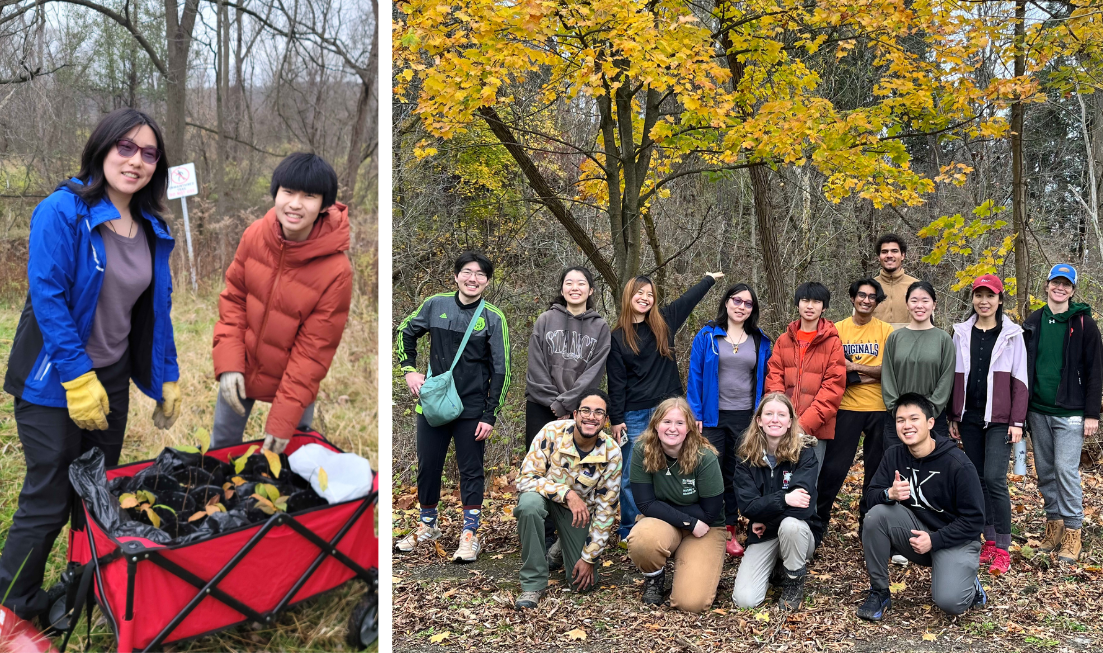Biochemistry student works with Nature at Mac to plant rare, Indigenous fruit trees

Terralyn Yim turned her interest in the pawpaw into a meaningful act of reconciliation, growing dozens of saplings from seed, to plant on and around McMaster's campus.
It was on a trip to Charleston, South Carolina that Terralyn Yim first discovered pawpaw (Asimina triloba).
The third-year Honours Biochemistry student was travelling with family when she tried the fruit, which is native to North America and was once a staple food source for Indigenous populations.
She didn’t know it at the time, but that trip to Charleston would be the launching pad into a meaningful act of reconciliation that would see her collaborate with Indigenous leaders at McMaster to plant pawpaw trees on campus.
The seed of an idea
When Yim returned from her trip, she learned that pawpaw grew in Southern Ontario and began a hunt to purchase the fruit that looks like green mango, has a custard-like flesh and tastes like a blend of banana, mango and pineapple.
She and her brother, Keenan, were disappointed to only find the fruit available online — but they could get their hands on some seeds, if they had the patience to grow the fruit themselves.
“At first, we had planted the pawpaw seeds without much expectation that they would grow. We took care of the seedlings for about a year, and then so many ended up sprouting — we had about 40,” she says.
“That’s when we got curious about how to take care of them and ended up learning about the history, culture, and ecological relevance attached to them.”
Pawpaw is a Carolinian species found in Southwestern Ontario near Lake Erie and in the Niagara region.
For years, the fruit has been used by Indigenous Peoples for various purposes — as a food that’s eaten cooked, raw or sundried; as a sedative or laxative medicinal ingredient; and to make tools and clothing with the inner bark.
Learning about this rich history inspired Yim and her brother to take extra care of the saplings and find a way to engage other students at McMaster to learn more about the fruit.
“We thought it would be cool to donate the saplings to the McMaster community to encourage awareness and appreciation of Indigenous culture and history, inspire interest in our local ecosystems, and provide an opportunity for students to learn how to take care of plants,” she says.
“Wild pawpaw populations have declined significantly and have resulted in reduced diversity in our native Carolinian ecosystem. Since most people don’t know that Ontario has native fruits like the pawpaw, or its ecological connection to Carolina, we thought it would be an engaging opportunity for the community to learn more about the land they live on and its native ecosystems.”
The food forest at Mac
Yim connected with Adrianne Lickers Xavier, an assistant professor in Indigenous Studies, who was excited about the idea. Xavier brought in the Traditional Ecological Knowledge Committee, as well as the President’s Advisory Committee on Natural Lands, which advises on issues related to and concerning natural lands, environment, wildlife, and sustainability in and around McMaster’s campus.
“Growing anything well requires dedication, and growing trees from seed is difficult — it was inspiring for me to hear the story of these pawpaw that Terralyn and Keenan grew with intent and meaning to offer to the Indigenous community at Mac,” says Xavier. “It is the epitome of a gift, and for that I am grateful.”
Under the guidance of McMaster graduate Makasa Looking Horse, a traditional ecological knowledge coordinator, Yim and her brother joined a tree-planting event at McMaster’s Lower Campus. About 15 people attended the event and worked hard to plant many trees before the winter season.
The group planted in two locations: the McMaster Forest and the Food Forest. The pawpaw, planted along with Pin Cherry, American Plum, American Hazelnut, will be used for the future Indigenous Teaching Garden, an area of campus being curated with teaching spaces for Indigenous Studies and the Faculty of Science.
“It was very striking and exciting to see how many McMaster students and staff were involved in the food forest planting,” Yim says. “Knowing that there were that many people willing to get dirty to make a tangible difference was very uplifting.”
Taking it one step further
In addition to their home in the food forest, some of the pawpaw will be taken to a more prominent home on campus — the atrium of L.R. Wilson Hall.
A memorial garden has been established in the atrium to honour the late Chief Arnie General, a member of Six Nations who was integral to the creation and growth of Indigenous Studies at McMaster.
“This garden is meant to honour Chief Arnie’s dedication and support for the Indigenous education and community at McMaster, and to recognize the future of that relationship that still exists with Six Nations, Mississaugas of the Credit First Nation and the surrounding Indigenous communities,” says Xavier.
“We want his future generations to know we remember and value his care and support, and these pawpaw trees are a perfect example of the connections that we need between Indigenous and non-Indigenous learners to help make a brighter world for the future.”


